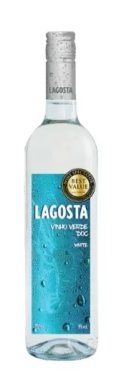Lagosta Vinho Verde White
€ 6.40
Delivery in 5-7 Business days - In stock

Lagosta Verde Branco DOC is a typical Portuguese wine from the Vinho Verde region, with a crystal-clear appearance and a citrus color with greenish hues. The taste is fruity, fresh, harmonious, and slightly sparkling. The aroma is fruity and intense, with citrus notes and white flesh.
Food-Pairing
The one and only party wine and aperitif for summer garden parties. Delicious with fish, salads, and pasta dishes.
Grapes: Arinto, Trajadura, Loureiro
Lagosta Verde Branco DOC is a typical Portuguese wine from the Vinho Verde region, with a crystal-clear appearance and a citrus color with greenish hues. The taste is fruity, fresh, harmonious, and slightly sparkling. The aroma is fruity and intense, with citrus notes and white flesh.
Food-Pairing
The one and only party wine and aperitif for summer garden parties. Delicious with fish, salads, and pasta dishes.
Grapes: Arinto, Trajadura, Loureiro
Who was João Camillo Alves?
Born in 1858 to a family with a small farm in Bucelas, he was at a particularly difficult time for the Portuguese wine industry, exacerbated from 1860 onwards by the arrival of phylloxera, which devastated vineyards throughout the region. Despite the bleak outlook, João Camillo Alves stood out for his entrepreneurial spirit. After completing primary school, he set up shop as a barber, which allowed him to establish valuable connections with the Lisbon residents who regularly visited Bucelas.
In this context of adversity, João Camillo Alves recognized the potential of the wines from the Bucelas region and, first as a mediator and then as a visionary entrepreneur, he turned adversity into an opportunity. He promoted the Bucelas name and its wines worldwide, at a time when the sector was beginning to recover with the emergence of solutions such as rootstocks and new production techniques. Thus, in 1881, the firm Alves & Freire was founded, specializing in the purchase and sale of wines. Along with his brother-in-law, Alves benefited from João Camillo Alves' strategic vision.
The wines were transported in oxcarts loaded with barrels of white Bucelas wine, which supplied Lisbon's taverns and pubs. In 1890, Alves & Freire ceased to exist, and João Camillo Alves decided to start his own business. The first decades of the 20th century saw significant national and international expansion, with groundbreaking strategies for the time, including bottled wine sales and exhibiting their wines at international fairs and competitions. They even won international prizes, medals, and awards (a bronze medal in the "Wine and Olive Oil" category at the Paris World's Fair in 1900 and a silver medal in 1908 at the exhibition celebrating the opening of the Brazilian ports, marking the first centennial).
João Camillo Alves eventually consolidated a substantial estate and extensive vineyards and farms in the Bucelas region, as well as personal prestige. Encouraged by the company's profits, they opened warehouses and a headquarters in Lisbon, on Calle Fernão Lopes. From the 1930s onward, subsequent generations took over the company and implemented innovative initiatives in oenology and marketing. It was around this time that emblematic brands such as Clarete, Romeira, Monte Serves, and Dumonte emerged, which later became associated with Caves Velhas. Around the 1950s, the company decided to expand and acquired the wine distributor "Vinícola da Amadora" in Lisbon. In the early 1970s, it changed its name to "CAVES VELHAS – Companhia Portuguesa de Vinhos de Marca" (CAVES VELHAS – Portuguese Branded Wine Company).
The company focused on the production and sale of high-quality wines with a high reputation, with an emphasis on improving profit margins. In 1971, Caves Velhas was integrated into Central de Cervejas (Central Beers). The following years were marked by significant political and social unrest. After the Carnation Revolution, Portugal was embroiled in the persecution of company executives and the company was occupied by workers, with the directors and managers being ousted. In 1989, Quinta do Boição, which produces high-quality white wines, was acquired. Central de Cervejas, along with Caves Velhas, was acquired by the Colombian brewery group Bavaria, which was sold to its current shareholders in 2001 and integrated into the Enoport group in 2005, along with Adegas Camillo Alves and Caves Dom Teodósio.
Caves Velhas maintains strong ties to the city of Bucelas, and these ties are reflected in the local architecture. An interesting example is the "Wine and Wine Museum" in the historic center of Bucelas, housed in a building that belonged to the Camillo Alves family, the former owners of Caves Velhas, and dates back to the 19th century. Besides serving as a family home, the building also housed a wine cellar and a warehouse, both of which have since been renovated. Another architectural remnant still standing in Bucelas are the old Caves Velhas cellars. These have been transformed and renovated and now serve as a wine aging center and storage facility. Visitors can participate in wine training sessions and take a guided tour of the cellars, experiencing the aroma and warmth of Caves Velhas's precious nectar.
Despite the changes, sales, and integrations, the spirit, know-how, traditions, and brands of Caves Velhas remain alive, consolidating their status as a prestigious and recognised heritage in the Portuguese wine sector.
Alcoholcontent
9 %vol
Store & Serve
Serve at 8 ºC. Drink young.
Awards & Critics
Producer: Caves Velhas - Enoport United Wines
Region: Vinho Verde
PorteVinho
